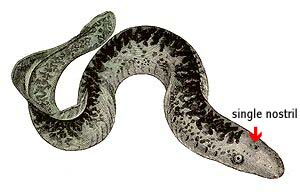

Classification:
Phylum
Chordata
Subphylum Vertebrata
Class Cephalaspidomorphi
Order Petromyzontiformes
Family Petromyzontidae
Subfamily Petromyzontinae
The sea lamprey is one of the close to 50 species of jawless fishes that inhabit temperate rivers and coastal seas. Closely resembling the first jawless fishes that swam the oceans, the lampreys are the only living vertebrates with a simple nasal aperture located on the dorsal side of its head, between large visible eyes (not detectable in the larvae). Unlike the cartilaginous hagfishes (Myxini) with which they were once classified, they have complete braincases and rudimentary true vertebrae in their internal cartilaginous skeletons.
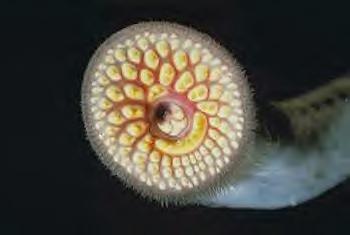 This
cylindrical eel-like creature can grow to 91 cm in length although mature
lampreys usually measure around 60-80 cm. The weight of the adult
female can reach up to 2.5 kg, with males usually weighing in at about
a kilogram less. They have seven separate gill openings, that lead
to seven branchial cells, on both sides, close to their eyes. Their
ventrally-oriented mouths that appear slit-like when closed, are modified
into oval sucking discs with numerous yellow, horny, hooked, epidermal
'teeth' arranged in rows with a rasping tongue armed with three larger
teeth located centrally.
This
cylindrical eel-like creature can grow to 91 cm in length although mature
lampreys usually measure around 60-80 cm. The weight of the adult
female can reach up to 2.5 kg, with males usually weighing in at about
a kilogram less. They have seven separate gill openings, that lead
to seven branchial cells, on both sides, close to their eyes. Their
ventrally-oriented mouths that appear slit-like when closed, are modified
into oval sucking discs with numerous yellow, horny, hooked, epidermal
'teeth' arranged in rows with a rasping tongue armed with three larger
teeth located centrally.
The smooth slimy skin is
colored varying shades of olive to yellowish-brown 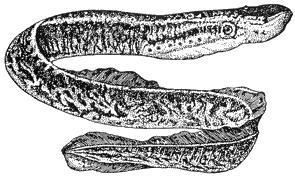 with dense dark green or dark brown mottling towards the dorsal side and
pale grey on the ventral side. They have two well-separated dorsal
fins and a single ventral fin. Fins are colored reddish brown towards
their edges. Adults nearing the breeding season develop additional
fin folds, the male having a strong ridge along the back, the female a
crest-like fin behind the vent. Since they lack pectoral fins and
a swim-bladder, they are often bottom-dwellers that attach themselves to
various stony and rocky substrates by their mouths (Petromyzon literally
means 'stone-sucker') .
with dense dark green or dark brown mottling towards the dorsal side and
pale grey on the ventral side. They have two well-separated dorsal
fins and a single ventral fin. Fins are colored reddish brown towards
their edges. Adults nearing the breeding season develop additional
fin folds, the male having a strong ridge along the back, the female a
crest-like fin behind the vent. Since they lack pectoral fins and
a swim-bladder, they are often bottom-dwellers that attach themselves to
various stony and rocky substrates by their mouths (Petromyzon literally
means 'stone-sucker') .
Original
Distribution: Sea lampreys are native to the coastal regions of both
sides of the North Atlantic Ocean, from Labrador, Canada to the Gulf of
Mexico, FL on one side and Norway (Iceland and the Barents Sea) to the
western Mediterranean Sea and northern Africa on the other.
Current Distribution: The sea lamprey was first discovered in Lake Ontario in 1835, Lake Erie in 1921, Lake Huron 1932, Lake Michigan 1936, and Lake Superior 1946. Reproducing populations were found in all of these upper lakes by 1947. Studies on various great lake tributaries since 1979 have situated the lamprey in the following states: Illinois, Indiana, Michigan, Minnesota, New York, Ohio, Pennsylvania, and Wisconsin.
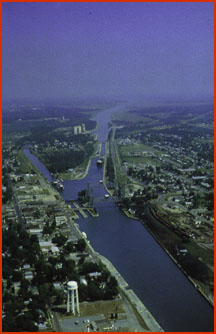
Site
and Date of Introduction: Lampreys had already been located in Lake
Ontario as early as 1820. Its progress into the inner lakes was delayed
for almost 100 years by the impassable barrier of the Niagara Falls.
This barrier was eventually surmounted through the construction of the
Welland Canal.
The Welland Canal, which opened in 1829, provided a commercial transportation route (with 26 locks) between the Welland River and the Niagara River. Further improvements created a direct route between Port Robinson in Lake Ontario and Port Colbourne in Lake Erie in 1830. However, the Grand River prevented further invasion of the lampreys as it supplied water to the highest point of the canal resulting in a two-directional flow: southward to Lake Erie and northward to Lake Ontario. The Grand River was eventually severed from the waterway in 1921, allowing water to flow freely between Lake Ontario and Lake Erie. It was around this time that the first sea lamprey was observed in the waters of Lake Erie. It only took 25 years for the sea lampreys to fully extend their range to include the remaining great lakes.
Modes of Introduction: As with a lot of the invasive species of the Great Lakes, the principal vector of sea lamprey colonization was the construction of canals, dams, and flood control structures throughout the east coast of the United States. The already wide range of the sea lamprey was enhanced by ships that plied trade routes bringing with them lamprey-contaminated ballast water. The ability of their suckerlike mouths to attach to anything, from stones to wooden ship hulls to fishes may have also facilitated this spread. Another reason may be the use of lamprey larvae as bait in sport-fishing.
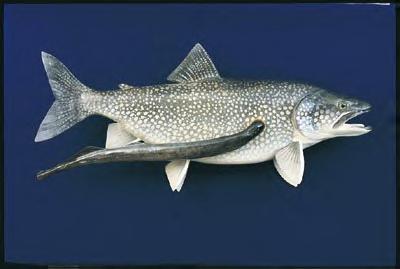 Reasons
Why it has Become Established: The sea lampreys had enormous negative
impacts on the Great Lakes fisheries. As they did not evolve with naturally
occurring Great Lakes fish species, their aggressive, predaceous behavior
gave them a strong advantage over the abundant native fish prey, including
the top predators of the lake ecosystem like the lake trout. The absence
of natural predators, competitors, parasites, and pathogens in this new
habitat facilitated the establishment and spread of sea lampreys in this
area. Lampreys were able to feed on a large variety of deepwater fishes
such as salmon, rainbow trout, whitefish, chubs, burbot, walleye and catfish.
They attach and feed on the fish until they are satiated or until the fish
dies. This mode of feeding enhances their natural dispersal abilities.
Reasons
Why it has Become Established: The sea lampreys had enormous negative
impacts on the Great Lakes fisheries. As they did not evolve with naturally
occurring Great Lakes fish species, their aggressive, predaceous behavior
gave them a strong advantage over the abundant native fish prey, including
the top predators of the lake ecosystem like the lake trout. The absence
of natural predators, competitors, parasites, and pathogens in this new
habitat facilitated the establishment and spread of sea lampreys in this
area. Lampreys were able to feed on a large variety of deepwater fishes
such as salmon, rainbow trout, whitefish, chubs, burbot, walleye and catfish.
They attach and feed on the fish until they are satiated or until the fish
dies. This mode of feeding enhances their natural dispersal abilities.
The great lakes also provided good areas for certain portions of the sea lamprey’s life cycle. Easy access to spawning grounds in rivers and streams combined with the natural fecundity of female sea lampreys (capable of laying 30,000-100,000 eggs per period) also increase the supply of new sea lampreys.
Ecological
Role:
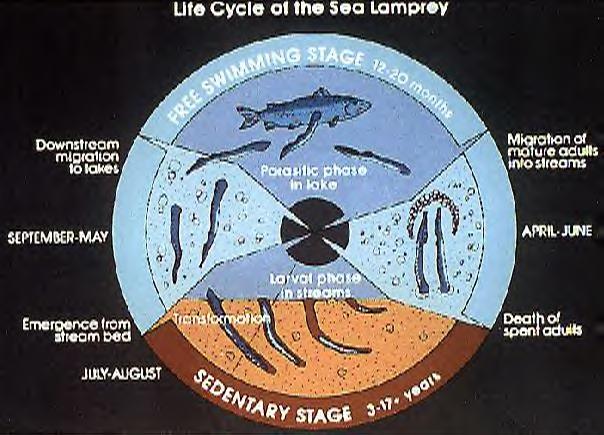 In the spring and early summer, adult sea lampreys ascend streams and rivers
to spawn. The males construct depressions that serves as nests or redds
along sandy bottoms with gravel or small stones. The female sea lamprey
then lays 30,000-100,000 eggs and the male fertilizes them after which,
both adults drift downstream and die.
In the spring and early summer, adult sea lampreys ascend streams and rivers
to spawn. The males construct depressions that serves as nests or redds
along sandy bottoms with gravel or small stones. The female sea lamprey
then lays 30,000-100,000 eggs and the male fertilizes them after which,
both adults drift downstream and die.
It takes a few weeks for the fertilized eggs to hatch. The blind and toothless larvae or ammocoetes emerge from the nest, drift downstream to a calm area along the stream bank and then burrow into the mud where they filter-feed on algae, detritus, and various small organisms. After 3-14 years in this state, they undergo a transformation period in the late summer and fall.
They develop eyes and a sucker-like mouth with sharp teeth and begin to swim downstream towards the Great Lakes. After they have entered the Great Lakes, the transformed sea lampreys begin to feed on fish. Each sea lamprey in this parasitic-phase will spend between 1-1.5 years in the Great Lakes, each destroying an estimated 90 kilograms of fish each.
The adults mainly feed on dead or netted fish but they may also attach themselves to healthy teleosts, chondrichthyes, and marine mammals. Examples of common prey include: mackerel, shad, cod, haddock, pollack, salmon, basking sharks, herrings, swordfish, hake, sturgeons, eels, and trout. They attach by creating suction with their disclike mouths after which they bore a hole through the scales and skin of fishes with their rasplike tongue. An anticoagulant is secreted from their buccal glands and they take in the prey's flesh, blood, and other bodily fluids.
Benefits: Anthropocentric benefits include lampreys are sources of food both in Europe (where they are considered as delicacies) and New England. The ammocoetes also serve as bait in sport-fishing.
Threats:
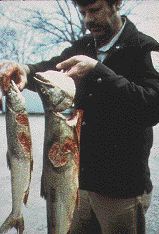 Attack and parasitic feeding on other fishes by adult lampreys often results
in death of the prey, either directly from the loss of fluids and tissues
or indirectly from stress and secondary infection of the wound. Of the
fish that survived attacks by lampreys, 85% of various species had been
attacked up to five times. The species' introduction to the Great Lakes
and its later abundance, combined with water pollution and overfishing,
resulted in the decline of several large native species. They first
affected the aquatic system by preying upon the Great Lakes ecosystem's
top predator, the lake trout (Salvelinus namaycush). As the
populations of lake trout declined, the lampreys turned to smaller fish
including several ciscoes (Coregonus
sp). and walleye (Stizostedion
vitreum). Consequently, there was a collapse in the commercial fisheries
during the 1940s and 1950s in many parts of the Great Lakes, particularly
in Lake Huron and Lake Michigan, and in eastern Lake Superior. Lake trout
catch in Lake Huron fell from 7.5 million kg in 1937 to virtually nothing
in 1947. In Lake Michigan, U.S. catch fell from 12.1 million kg in 1946
to 885 kg in 1953. In Lake Superior, catch dropped from an average of 10
million kg to 800,000 kg in 1961.
Attack and parasitic feeding on other fishes by adult lampreys often results
in death of the prey, either directly from the loss of fluids and tissues
or indirectly from stress and secondary infection of the wound. Of the
fish that survived attacks by lampreys, 85% of various species had been
attacked up to five times. The species' introduction to the Great Lakes
and its later abundance, combined with water pollution and overfishing,
resulted in the decline of several large native species. They first
affected the aquatic system by preying upon the Great Lakes ecosystem's
top predator, the lake trout (Salvelinus namaycush). As the
populations of lake trout declined, the lampreys turned to smaller fish
including several ciscoes (Coregonus
sp). and walleye (Stizostedion
vitreum). Consequently, there was a collapse in the commercial fisheries
during the 1940s and 1950s in many parts of the Great Lakes, particularly
in Lake Huron and Lake Michigan, and in eastern Lake Superior. Lake trout
catch in Lake Huron fell from 7.5 million kg in 1937 to virtually nothing
in 1947. In Lake Michigan, U.S. catch fell from 12.1 million kg in 1946
to 885 kg in 1953. In Lake Superior, catch dropped from an average of 10
million kg to 800,000 kg in 1961.
In freshwater, sea lampreys are known to attack white sucker (Catostomus commersoni), longnose sucker (Catostomus catostomus), redhorse (Moxostoma sp.), yellow perch (Perca flavescens), rainbow trout (Oncorhynchus mykiss) , burbot (Lota lota), channel catfish (Ictalurus punctatus) , northern pike ( Esox lucius), and common carp (Cyprinus carpio) . Sea lamprey predation, in combination with other factors (i.e., overfishing and hybridization with more common cisco species), also led to the extinction of three endemic species of the Great Lakes: the longjaw cisco (Coregonus alpenae), the deepwater cisco (C. johannae), and the blackfin cisco (C. nigripinnis) .
The already weakened commercial fisheries were further devastated during the late 1940s when the alewife (Alosa pseudoharengus) invaded the Great Lakes from the Atlantic Ocean. Because the sea lamprey had greatly reduced the population of large predators, alewife populations exploded and were followed by tremendous die-offs, resulting in additional changes to fish species composition in the lakes. Sea lampreys also took a toll on the introduced salmon in the Great Lakes, much to the dismay of anglers and state agencies. Although the number of sea lamprey in the Great Lakes has been reduced, they still kill substantial numbers of lake trout in some areas and are thus impeding the rebuilding of established populations.
Some cases have been documented of lampreys attacking swimmers in both the Great lakes and off European coastlines, causing stinging pain, bleeding, and some scarring.
Control Level Diagnosis: Medium Priority: The problem of sea lampreys has been around since the 1940s when they started decimating the commercially-important fish populations of the Great Lakes and various government and private institutions have established rigorous programs for sea lamprey control in the Great Lakes. As a result, the lamprey was not as abundant as it once was but fish populations have yet to recover their robust levels. Both vigilance in the implementation of these projects as well as improvements in efficiency and effectiveness are needed in order for commercial fisheries to regain their old populations.
Control Methods: The obvious economic repercussions of the sea lamprey invasion have prompted US and Canadian agencies at every level (state, federal, provincial) to participate in the Integrated Management of Sea Lamprey (IMSL) process proposed by the Great Lakes Fishery Commission (GLFC). The GLFC was created in 1955 in order to control and eradicate the sea lamprey at an estimated cost of $10 million annually. Programs of integrated sea lamprey management includes lampricide control, construction of barriers in streams to block sea lamprey entry, and an experimental program to reduce spawning success by releasing sterilized male sea lampreys.
Controls targeting the larval stage
Researchers at the Hammond bay Biological station tested more than 6000 chemicals for possible lampricidal qualities before they discovered the selective chemical agent, 3-trifluoromethyl-4-nitrophenol (TFM). It was first used in 1958 to control lamprey populations in Lake Superior. Lakes Michigan and Huron followed in 1960, Lake Ontario in 1972, and Lake Erie in 1986. The overall effect of TFM was the reduction of the sea lamprey population by 90% of its 1961 peak.
Another lampricide used in conjunction with TFM is Bayer 73 (2',5-Dichloro-4'-nitrosalicylanilide). Bayer 73 is non-selective for sea lamprey larvae and toxic to other organisms. Due its high level of toxicity, 98 parts of TFM are added to two parts of Bayer 73 to produce a 98:2 mixture.
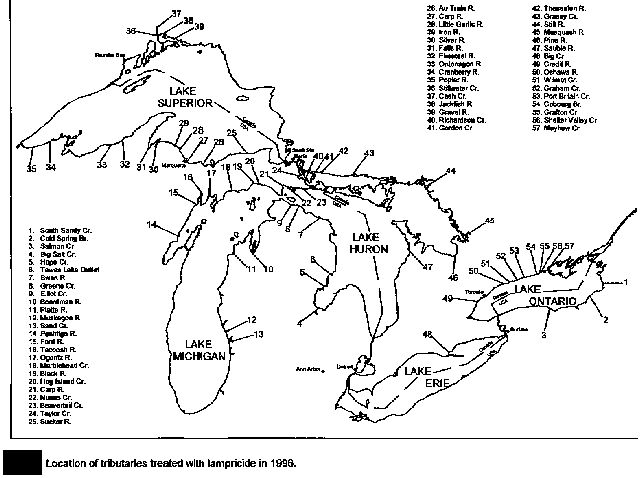
Although it is still one of the most widely-used methods of control, recent findings regarding the high sensitivity of native inhabitants to these lampricides (other lampreys like the threatened American brook lampreys and endangered silver lamprey; fishes like walleye, pickerel, northern pike, bullhead, catfish, logperch; and invertebrates like hydra, turbellarians, burrowing mayflies, blackflies, aquatic worms, eropdellid leeches, caddisflies, pink heelsplitters, snails, and clams), as well as its high cost have prompted the GLFC to reduce the amounts of applied TFM as well as look for other alternatives.
Controls targeting the spawning stage
Weirs
The earliest methods of control targeted the lamprey spring-summer spawning process by preventing the sea lampreys from ascending to lakes and rivers. For small rivers and streams, V-shaped mechanical weirs consisting of interlinked panels of wire mesh that stretched across the whole river, allowing water to flow through and interrupting the upstream progress of both fishes and sea lampreys and concentrating them into cone-shaped traps. The fishes were eventually released while the adult lampreys were destroyed. However, debris would eventually collect along the wire mesh, restricting water flow and creating a damming effect that led to either the collapse of the weir or flooding of surrounding areas.
Electrical weirs soon replaced the mechanical weirs. Composed of two sets of electrified rods suspended in the water, aquatic creatures were stunned with bursts of electricity if they attempted to pass through the weir, funneling them into traps where they could be sorted. This barrier was prone to electrical failures and flooding that allowed the sea lampreys to bypass the system altogether and it also proved harmful to some native spawning fish that would get electrocuted on their way upstream. The use of weirs was discontinued in 1979.
Barrier dams
The construction of various types of barrier dams soon replaced the weirs. The advantages of these installations included the improved passage for non-target species; efficient control of streams where physical characteristics make lampricide treatment difficult and impractical; long-term savings in time, manpower and related costs; reduced dependency on lampricides and quantity of lampricides added to the environment.
Low-head barrier dams that provide 2-4 ft drops are located near the mouths of tributary streams to prevent adult sea lamprey from migrating upstream to suitable spawning habitat. Overhanging steel plates are placed on the crests of dams to both allow the movement of rainbow trout (that are able to jump barriers) while denying passage to adult sea lampreys. At present there are 52 tributaries in Canada and 19 in the United States with low-head barrier dams. While low-head barrier dams do not appear to cause mortality of nontarget species, they may have several negative impacts on stream communities (like non-jumping fish and other invertebrates) by inhibiting movement during reproductive periods and restricting access to food and suitable habitat.
Adjustable-crest or inflatable barriers provide temporary damming structures in order to minimize the effect on nontarget species while impeding the passage of sea lampreys. During non-spawning periods, the crests rest close to the water bottoms. When spring and summer arrives the crest may be raised by inflating an air bladder. This system is primarily computer-controlled and barrier height is dependent on the level of the water at any given time. Salmonid and other spawning fish species are provided with jumping pools of special passageways to help them overcome this barrier.
Sea lampreys are poor swimmers, often tiring easily. Velocity barriers exploit this inability by creating sites with powerful, fast moving currents oriented in the opposite direction. These also come with suction-free surfaces that the lampreys cannot attach themselves to. Experimental studies indicate that this type of dam may have great potential in both passing the fish upstream and hindering sea lamprey passage.
Another type of barrier in the experimental stage is the electrical barrier. DC-powered and built into the stream beds, they are said to be more efficient than the electrical weirs as they rely on new designs.
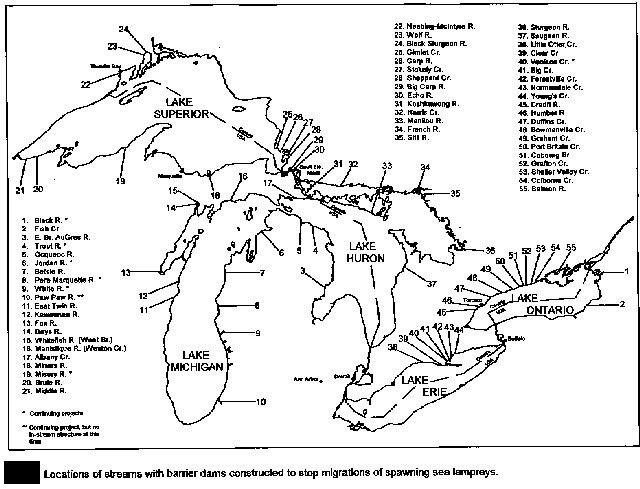
Other controls
In the sterile male release approach, first implemented in 1991, adult male sea lampreys were trapped at barrier dams, sterilized, and released into several Lake Superior tributaries. Eggs from sea lamprey nests were subsequently examined to determine the rate of effective fertilization.
A reliable assessment of the status of sea lampreys is required in order to improve the information used to select streams for lampricide treatment, to effectively apply alternative control methods, and to monitor the effectiveness of the whole control program. Further research is required in order to provide quantitaive information. This allows control efforts to be applied where they will cause the greatest reduction in lamprey numbers with the least impact on other nontarget organisms.
References:
Baggio, A. 4 Oct 2001. SEA LAMPREY. http:// www.science.mcmaster.ca /Biology /Harbour /SPECIES/ SEALAMP / TITLE.HTM.Photo credits:Barker, J. 2001. 4 Oct 2001. Sea Lamprey. http://ourworld.compuserve.com/homepages/ BMLSS/ lamprey2.htm # Gateway.
Bergstedt, R.A., C.P. Schneider, and R. O'Gorman. 2001. Lethality of sea lamprey attacks on lake trout in relation to location on the body surface. Transactions of the American Fisheries Society. 130(2): 336-340.
Claudi, R. and J.H. Leach, eds. 2000. Nonindigenous Freshwater Organisms: Vectors, Biology, and Impacts. CRC Press LLC, Boca Raton, FL.
Daniels, R.A. 2001. Untested assumptions: The role of canals in the dispersal of sea lamprey, alewife, and other fishes in the eastern United States. Environmental Biology of Fishes. 60(4): 309-329.
Dawson, V.K., K.B. Cumming, and P.A. Gilderhus. 1977. Efficacy of 3-Trifluoromethyl-4-nitrophenol (TFM), 2',5-Dichloro-4'-nitrosalicylanilide (Bayer 73), and a 98:2 mixture as lampricides in laboratory studies. Department of the Interior Fish and Wildlife Service. 1-5.
Downs, W., 1982. Sea Lamprey: Invader of the Great Lakes (fact sheet). University of Wisconsin Sea Grant Institute.
Fetterolf, C. 15 Oct 2001. Sea Lamprey in the Great Lakes. http://biology .usgs.gov/s+t/SNT/ noframe/ gl129. htm.
Fishbase.org. 2001. 9 Sept 2001. Species summary. http://www.fishbase.org/Summary ? Species Summary. cfm?genusname = Petromyzon &species name=marinus.
Fuller, P. and L. Nico. 2000. 20 Sept 2001. Nonindigenous fishes-Petromyzon marinus. http://nas.er.usgs. gov/fishes/accounts/petromyz/pe_marin.html.
Great Lakes Fishery Commission. 2001. 17 Oct 2001. Sea lamprey barriers: New technologies help solve an old problem (Fact sheet 5). www.glfc.org/pubs/FACT_5.pdf.
Great Lakes Fishery Commission. 10 Oct 2001. Sea Lamprey Control. http://www.glfc.org/lampcon.htm.
Great Lakes Information Network. 2001. 10 Oct 2001. Sea Lamprey
in the Great Lakes Region. http://www.great-lakes.net/envt/flora-fauna/invasive/lamprey.html.Hunn, J.B., and W.D. Youngs. 1980. Role of physical barriers in the control of sea lamprey (Petromyzon marinus). Can. J. Fish. Aquat. Sci. 37: 2118-2122.
Krause, C. 26 Apr 1996. 20 Oct 2001. Effects of Lampricides on Sea Lamprey and Non-Target Species. http://c_krause.tripod.com/lampricides_paper.htm.
Mills, E.L., J.H. Leach, J.T. Carlton, and C.L. Secor. 1993. Exotic species in the great lakes-a history of biotic crisis and anthropogenic introductions. Journal of Great Lake Research. 19(1):1-54.
National Sea Grant Network and Geographic Education Alliances. 1999. 4 Oct 2001. Sea Lamprey-EATM Page. http://ag.ansc.purdue.edu/EXOTICSP/lamprey.htm.
New York Sportfishing and Aquatic Resources Education Program and Cornell University. 11 Oct 2001. Sea Lamprey Petromyzon marinus. http:// www.sarep.cornell.edu/ Sarep/ fish/ Petromyzontidae/ sealamprey.html.
Randall, T.A. 20 Sept 2001. Species Summary for Petromyzon marinus. http://lionfish.ims.usm.edu/~musweb/pmarinus.htm.
The Fish Shop. 2001. 4 Oct 2001. The Sea Lamprey. http://www.waterland.net/visschenwinkel/sealamp.htm .
United States Fish and Wildlife Service. 10 Oct 2001. Sea Lamprey Management Home Page. http://midwest.fws.gov/Marquette/index.html.
University of Guelph, Michigan State University, the University of Wisconsin - Madison, Fisheries and Oceans Canada and the Ontario Ministry of Natural Resources. 2000. 12 Oct 2001. Biological Impacts of Low-head Barrier Dams Research Page. http://www.axelfish.uoguelph.ca/research/BILD.htm.
Photo 1: www.peche.org/poissons_eau_douce/ lamproie_marine.jpg (slightly edited: put background)Author: Dawn P. Toledo
Photo 2: http://www.waterland.net/visschenwinkel/sealamp.htm (edited: put in some text)
Photo 3: www.seagrant.umn.edu/ art/splamprey.jpg
Photo 4: http://www.waterland.net/visschenwinkel/sealamp.htm
Photo 5: http://www.graphicmaps.com/webimage/countrys/namerica/greatlk.gif and http://nas.er.usgs.gov/fishes/accounts/petromyz/pe_marin.html (edited)
Photo 6: http://www.greatlakesboating.com/issues/jun98/pics/wellandcanal.jpg
Photo 7: http://soma.npa.uiuc.edu/courses/physl490b/models/lamprey_swimming/lamprey_swim.html
Photo 8: midwest.fws.gov/Marquette/ images/cycle.jpg
Photo 9: biology.usgs.gov/s+t/SNT/ lrgimage/gl129f04.jpg
Photo 10: http://www.glfc.org/slft/slar96/96f7.gif
Photo 11: http://www.glfc.org/slft/slar96/96f8.gif